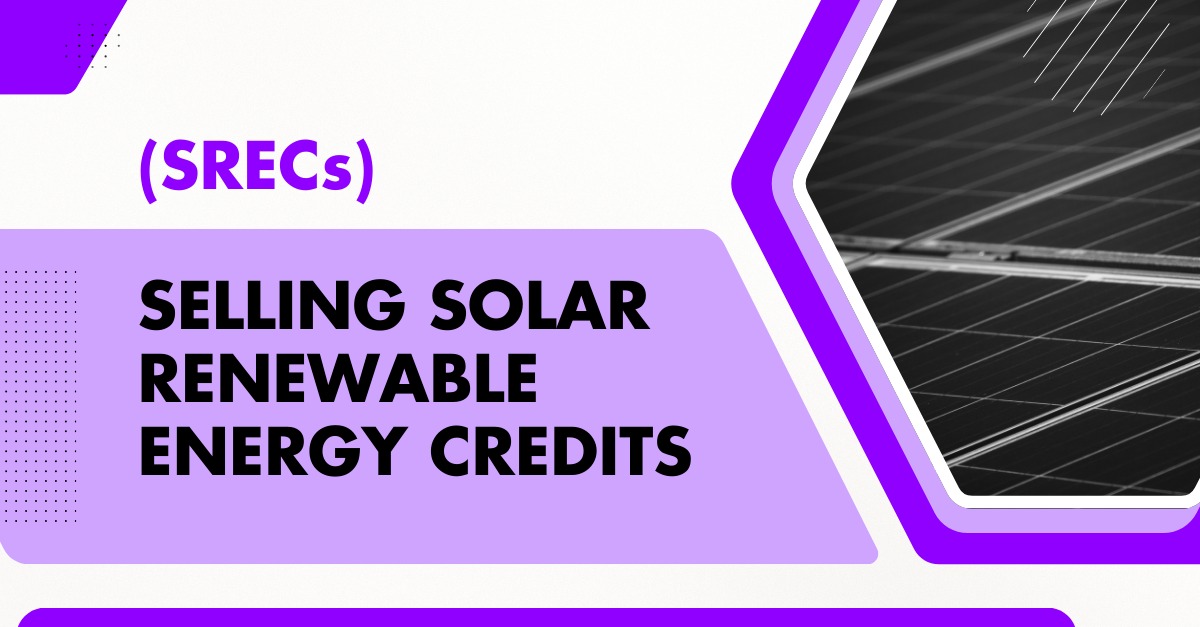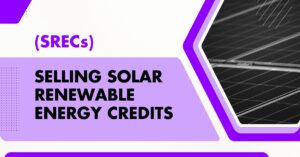From Solar Energy to Profit: What It’s Like to Sell Solar Renewable Energy Certificates (SRECs)

From Solar Energy to Profit: What It’s Like to Sell Solar Renewable Energy Certificates (SRECs)
Your solar panels are quietly humming away on your roof, turning sunlight into valuable electricity for your business.
But what many people don’t realize is that those same panels can create another valuable commodity, something you can actually sell for cold, hard cash.
Solar Renewable Energy Certificates, or SRECs, are digital certificates that represent the environmental benefits of your clean energy production. Believe it or not, you can sell them.
It may help to think of SRECs as your reward system for going green. Every time your solar panels generate 1,000 kilowatt hours (1 megawatt hour) of electricity, you earn one SREC that someone else likely wants to buy.
So what does it look like if you’re on the selling side of SRECs? We’ll walk you through the entire journey in this post, showing you how to understand the marketplace, maximize your earnings, and feel good about contributing to a greener and cleaner energy future.
What Are Solar Renewable Energy Certificates (SRECs)?
Solar Renewable Energy Certificates, in a nutshell, are digital proof that you’ve generated clean electricity from solar power. Each SREC represents 1,000 kilowatt-hours (1 MWh) of solar electricity produced by your system.
Why do these certificates exist? The answer lies in state renewable energy standards, as many states require utility companies to source a certain percentage of their electricity from renewable sources. When utilities can’t generate enough renewable energy themselves, they purchase SRECs from solar producers like you to meet their legal obligations.
For example, if a state says that the utilities must meet 20% of its overall electricity needs with renewable energy sources by 2030, the utility company might respond by saying they’re only able to generate 15% from their own renewable projects. They will then buy SRECs from residential and commercial solar owners to make up the difference.
In essence, this creates a market where your environmental benefits have real monetary value. You’re saving money on your electric bill, but also earning money by helping utilities comply with clean energy laws.
The SREC market varies dramatically by state. Some states, like New Jersey, Maryland, and Massachusetts, have robust SREC programs with high demand and good prices. Other states don’t have SREC programs at all, relying on different renewable energy programs instead.
The Journey of an SREC: From Solar Panel to Marketplace
Let’s follow the life cycle of an SREC from the moment sunlight hits your panels to the moment you get paid.
Step 1: Solar Energy Generation
You’re probably already familiar with this part: your solar panels convert sunlight into electricity. A production meter tracks exactly how much electricity your system generates, then this meter reading becomes the foundation for your SREC earnings.
Step 2: SREC Creation and Tracking
Once your system produces 1,000 kilowatt-hours of electricity, you’ve earned one SREC. But you can’t just claim it yourself. The process requires official verification through your state’s renewable energy tracking system.
Most states use electronic tracking platforms like GATS (Generation Attribute Tracking System) or PJM-EIS. These systems monitor your solar production in real-time and automatically create SRECs in your account when you hit the 1 MWh threshold.
Step 3: Verification and Certification
Next, your state agencies or third-party verifiers confirm that your SRECs represent legitimate solar energy production. This helps to prevent fraud and maintain overall market integrity. The verification process typically happens automatically through your tracking system, but some states require additional documentation.
Step 4: Marketplace Entry
Once verified, your SRECs enter the marketplace. You can sell them through several channels, including:
- Direct sales to utilities
- SREC brokers and aggregators
- Online marketplaces
- Long-term contract agreements
Step 5: Sale and Transfer
When someone purchases your SREC, the certificate transfers from your account to theirs. The buyer (usually a utility company) then “retires” the SREC, meaning it can never be sold again. This retirement ensures that the environmental benefit gets counted only once.
What It’s Like to Be an SREC Seller
Selling SRECs becomes part of your monthly routine, like checking your bank statement or paying bills. Here’s what the experience might look like:
Daily Monitoring
Most SREC sellers develop a habit of checking their solar production regularly, but there’s no “rule” about how often you need to do this.
You’ll likely find yourself glancing at your monitoring app every day to see how much electricity your system generated yesterday, but you don’t necessarily have to. On sunny days, you might feel a little thrill knowing you’re earning both electricity savings and SREC credits.
Monthly SREC Generation
Depending on your system size and local solar conditions, you might earn anywhere from one to several SRECs per month. A typical 8kW system in a sunny location generates about 10-12 kWh annually, which translates to 10-12 SRECs.
Administrative Tasks
Being an SREC seller requires some paperwork, but it’s manageable. You’ll need to:
- Register with your state’s tracking system
- Maintain records of your solar production
- File periodic reports (requirements vary by state)
- Track your SREC inventory and sales
Many sellers describe the administrative side as “tedious but worth it.” The paperwork isn’t complicated but staying organized helps maximize your earnings.
Working with Brokers
Most small-scale solar owners work with SREC brokers rather than selling directly to utilities. Brokers handle the administrative heavy lifting and often provide better prices through bulk sales. They typically charge a commission of 5-15% but this partnership can save you significant time and effort.
Essentially, you send your broker your production data once a month, and they handle everything else. You just wait for the check to arrive.
Market Volatility Stress
SREC prices fluctuate based on supply and demand, policy changes, and market conditions. Experienced sellers learn to ride out the ups and downs, but newcomers sometimes stress about price swings. One month you might earn $300 per SREC, the next month only $150.
The Financial Side of Selling SRECs
SRECs create a secondary revenue stream that can significantly boost your solar investment returns. Here are the financial realities.
Revenue Potential
SREC income varies widely depending on your location and market conditions. In high-value markets like Massachusetts or New Jersey, a SREC might sell for $300 to $400. In newer markets, like Ohio, prices might fall below $10 per SREC.
There are several key factors that influence how much you can earn:
- State Policy Strength: States with aggressive renewable energy standards and penalties for non-compliance typically have higher SREC prices.
- Supply and Demand: If too many people install solar systems, SREC supply increases and prices may drop. Conversely, strong utility demand drives prices up.
- Compliance Years: SRECs often have vintage years, and prices can vary based on which compliance period they satisfy.
- Market Maturity: Newer SREC programs often have higher prices that stabilize (and sometimes decrease) as markets mature.
Maximizing Your SREC Value
Smart sellers employ several strategies to optimize their earnings:
For example, some sellers track market trends and time their sales during high-demand periods. However, this requires market knowledge and carries risk.
Also, you can sell SRECs on the spot market for immediate payment or sign long-term contracts that provide price stability but potentially lower returns.
Finally, don’t forget about the aggregation benefits, as working with brokers or joining seller groups often yields better prices than individual sales.
Long-term Value Considerations
SREC values tend to decrease over time as solar adoption increases and markets mature. Early participants in SREC programs often enjoyed higher prices that gradually declined as supply caught up with demand.
However, some states adjust their renewable energy standards upward over time, creating continued demand for SRECs. The key is understanding your state’s long-term renewable energy goals and policy trajectory.
The Environmental and Social Impact of Selling SRECs
Beyond the financial benefits, selling SRECs contributes to meaningful environmental progress. Every SREC you sell represents 1,000 kilowatt-hours of clean electricity that displaced fossil fuel generation.
Supporting the Clean Energy Transition
When you sell SRECs, you’re helping utilities meet renewable energy mandates without building their own solar projects. This accelerates clean energy adoption across your state and reduces overall greenhouse gas emissions.
Consider the ripple effect: Your commercial solar system might seem small, but when aggregated with thousands of other SREC sellers, it represents substantial clean energy capacity that utilities can count toward their renewable energy goals.
Economic Development Benefits
SREC programs create local jobs in solar installation, maintenance, and administration. They also keep energy dollars in your community rather than shipping them to out-of-state fossil fuel suppliers.
Educational Impact
Many SREC sellers become solar ambassadors in their communities. When neighbors see your system generating both electricity savings and SREC income, they’re more likely to consider solar for themselves. This word-of-mouth effect multiplies the environmental benefits of SREC programs.
Tips for Success as an SREC Seller
Ready to maximize your SREC earnings? Here’s practical advice from experienced sellers:
Research Your State’s Program
Before you start selling, understand your state’s specific SREC requirements in detail. Some states have registration deadlines, ongoing reporting requirements, or specific eligibility criteria. Missing these details can cost you money.
Choose Your Sales Channel Wisely
Evaluate a few different selling options, including:
- Brokers: Easy but involve commission fees
- Direct utility sales: Potentially higher prices but more administrative work
- Online platforms: Convenient but may have limited liquidity
- Long-term contracts: Price stability but potentially lower overall returns
Stay Organized
Maintain detailed records of your solar production, SREC generation, and sales. Good record-keeping helps with tax reporting and ensures you don’t miss any earning opportunities.
Monitor Market Trends
Set up Google alerts for SREC news in your state. Follow solar industry publications and broker newsletters. Ultimately, taking the time to understand market trends will help you make better timing decisions.
But with that said…
Don’t Overthink Timing
While market timing can boost earnings, many successful sellers prefer consistent monthly or quarterly sales rather than trying to hit peak prices. The time spent analyzing markets might not justify the marginal gains.
Plan for Taxes
SREC income is generally taxable, so factor this into your financial planning. Keep detailed records and consult with a tax professional about the best way to report SREC earnings.
Network with Other Sellers
Join online forums or local solar groups where SREC sellers share experiences and market insights. Learning from others’ successes and mistakes can improve your own results.
Start Turning a Profit With Your Solar Panels Today
Selling SRECs transforms your solar panels from a one-time investment into an ongoing income stream. While the administrative requirements and market volatility can seem daunting at first, thousands of solar owners have successfully navigated the SREC marketplace and earned substantial supplemental income.
Whether SRECs add $500 or $5,000 to your annual income depends on your location, system size, and market conditions. But in states with active SREC programs, this revenue stream often improves solar payback periods by several years.
Ready to turn your solar production into profit? Start by researching your state’s SREC program and connecting with local brokers or online marketplaces. Your solar panels are already generating electricity. Now it’s time to capture the full value of the environmental benefits they create.
And if you’ve yet to install a solar system for your business and are looking to do so, partner with IE Construction. We’ll handle the construction so you can focus on making more money for your business in a renewable, sustainable way. The sun is shining, your panels are producing, and somewhere out there, a utility company needs your SRECs to meet their clean energy goals. Time to make that connection profitable.




